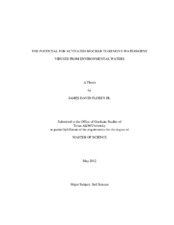| dc.description.abstract | The need for clean potable water and sustainable energy are two current and pressing issues with implications affecting the global population. Renewed interests in alternative energy have prompted researchers to investigate the full capacity of biofuels. These interests have led to not only the examination of current method limitations, but also to the investigation of new conversion methods. One promising method for bioenergy production is pyrolysis of lignocellulosic feedstocks. Through pyrolysis, a single crop may produce ethanol, bio-oil, and/or gaseous energy (syngas). The remaining solid phase product is a black carbon dubbed 'biochar'.
In the current study, biochar was used as a both an unamended sorbent and a precursor to form powdered activated carbons (PACs) capable of removing waterborne viruses. Biochar was activated with KOH, ZnCl2, and H3PO4 and analyzed using the Brunauer, Emmett and Teller (BET) method, a combination of Kjeldahl digest and ICP-MS, and scanning electron microscopy (SEM). Sorbents were tested in batch studies using phosphate buffered saline (PBS), surface water, and groundwater. Bacteriophages MS2 and thetaX174 served as viral surrogates.
All activation treatments significantly increased surface area, up to 1495.5 m2/g (KOH-activated). While the non-activated biochar was not effective in virus removal, the KOH-activated PAC had tremendous removal in the PBS/MS2 batch (mean 98.7% removal, up to 6.2 x 109 particles/mL, as compared to the Darco S-51: 82.3%).
As evidenced by this study, sorption efficiency will be governed by viral species, carbon type and concentration, and water quality. The results of this study indicate that biochar can serve as a precursor for a highly porous and effective PAC, capable of removing waterborne viruses from environmental waters. | en |


